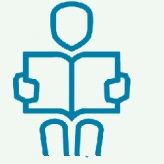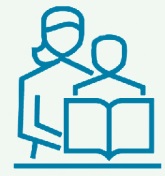Teaching reading is probably one of the hardest challenges for students with disabilities and those learning English. Many students can be one, two or even more years behind their classmates, so it is important to think about how you can help your child continue doing activities that foster reading and math while having fun during the summer.
Students with disabilities benefit from routines, schedules, and predictability. When summer comes, it is important for parents to think about how to keep some aspect of the time in routines. For example, does your child do better when he or she wakes up consistently around the same time? Does your child have favorites books that he or she can read alone and some more challenging books that you can read together? Does your child enjoy talking about words he or she sees and hears in the home and community? Can your child help you with cooking or other activities that use reading and math as a way to practice?
For students who are learning English, it is also important to maintain the native language. Their native language is rich in vocabulary that parents and extended family bring to conversation. It is critical to continue to engage your child in learning new vocabulary in their native language, which the family speaks. What we know from research is that all the skills in the native language transfer to English. This transfer is key to learning to read, so if you can teach your child to read in your native language, it will help your child learn English faster. One way you can do this is by having children's books in your native language and practice the same activities presented below in your native tongue. Remember that all these can help you get started in a very engaging and fun way, while helping maintain academic activities at home. Another fun way to practice reading in English and the native language is to have some easy books in English for your child to read and translate to you in your native language.
READ ALL ABOUT IT : ESTABLISHING A GOOD BALANCE OF FUN AND LEARNING THROUGHOUT THE DAY

DEVELOP A ROUTINE (Daily)
If your child does better with predictable schedules and routines, I recommend that you sit with them and talk about what that can look like at home. Once you identify two or three activities each day, take a picture of the child doing them and post them in a place where they can use it daily. The goal with creating a predictable schedule is that you and your child can know what you will do together and when. Ask your child to place the picture of each activity they choose to do, in the morning, midday, and afternoon. Choosing together can also help you plan the day and set expectations.

PRACTICE READING AT AN INDEPENDENT LEVEL (10-12 minutes)
Independent reading level refers to books that your child can read by themselves or know about 95% of the words. This practice is important in building fluency and comprehension. Set these kinds of books in a basket, so that your child can pick one each day. You can also find some of them online and even in a variety of languages. Remember these books are read without any help from adults. For this activity, the goal is for your child to read the book to you, a friend, a stuffed animal, a favorite doll, or a pet. They will be asked to read it twice and try to come up with questions. Once they are done, they can put the book back in the basket and prepare for the second activity reading with help from a parent/adult.

READING AT INSTRUCTIONAL LEVEL (10-12 Minutes)
Instructional reading level refers to books where the child needs assistance with many words. They may recognize many common words, which we call "sight words," but they are encountering new vocabulary, sentence structures, and decoding patterns. The Repeated Reading Strategy involves having the parent/adult and child read the book or text three times.
- The first time the adult reads it using their finger as they are reading each word.
- The second time you ask the child to try and read the words he knows together while you read.
- The third time you ask your child to try and read it alone and you help while showing each word as they read.

VOCABULARY DETECTIVE (10 minutes)
Vocabulary refers to the learning of new words for a child. Vocabulary is a large predictor of comprehension. Helping your child to add new words to their vocabulary will help them continue to connect concepts and practice new sentences that increase communication and interaction about the word. Each day tell your child to look around the home and community to find one or two words or things they don't know nor are familiar with them. For example, it can be finding new words at the grocery store, or on a TV show, in a book, or even a word someone said. Focus on talking about what the word means, write the word down on a 3 x 5 index card, talk about how they can use the word, and then model using it, and challenge your child to come up with ways of using it, throughout the day. Once you have five words, you can have the child review all the words during the week, to practice reading and vocabulary.